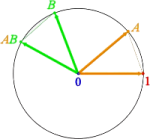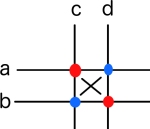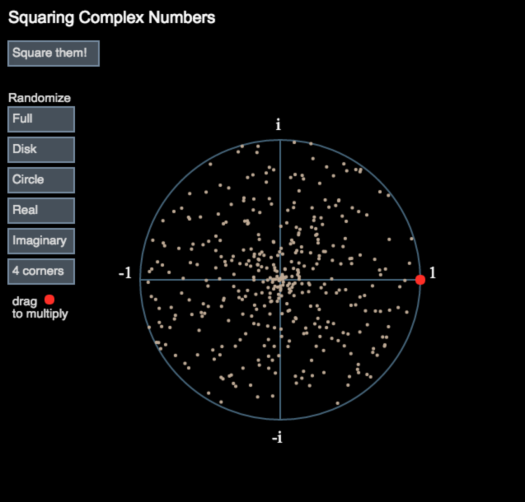Like so many other people, I was kept from appreciating the beauty and utility of mathematics because of the way it was taught to me.
The majority of introductions to complex numbers start with the elusive and mysterious square root of -1, denoted by i.
A number that has an i stuck on to it is called “imaginary” (a convenient differentiator to “real”). Being asked to learn something that is called “imaginary” is not very motivating to young learners who work best starting with concrete metaphors.

The imaginary number i is counterintuitive and confusing. And it’s not the coolest part. Sure, i was an important invention at a critical stage in the history of math when there was no good way to express z2 = -1. And yes, it makes a good ending to a long story (which happens to be true): math has advanced through several expansions of the concept of “number” … from the counting numbers to the wholes – to the negatives – to the fractions – to the irrationals – and finally to complex numbers – where i came along and saved the day.
But…does this mean that invoking i is the best way to explain complex numbers to novices – to everyday people? I join many others in saying that there is a better way to learn about the wonderful world of two-dimensional numbers. One voice among those is Kalid Azad.
 He speaks in metaphors and freely engages the visual mind to help us grasp math concepts using our whole brain. In his explanation on complex numbers, Azad says this about i: “It doesn’t make sense yet, but hang in there. By the end we’ll hunt down i and put it in a headlock, instead of the reverse.”
He speaks in metaphors and freely engages the visual mind to help us grasp math concepts using our whole brain. In his explanation on complex numbers, Azad says this about i: “It doesn’t make sense yet, but hang in there. By the end we’ll hunt down i and put it in a headlock, instead of the reverse.”
…..
When you get an intuitive, aesthetic feeling for why certain mathematical ideas are being taught, you become more motivated to learn the notation. The corollary: learning math notation without understanding why is like learning musical notation before ever being allowed to listen to or play music.
 Paul Lockhart, in A Mathematician’s Lament, compares the way math is taught to a nightmare scenario in which music is taught to students using sheet music notation only (no actual music is played or heard) – until the student is advanced enough to start “using” it.
Paul Lockhart, in A Mathematician’s Lament, compares the way math is taught to a nightmare scenario in which music is taught to students using sheet music notation only (no actual music is played or heard) – until the student is advanced enough to start “using” it.
What is a Two-Dimensional Number?
When I read that complex numbers are really no more “imaginary” than real numbers, I decided that I would start dismantling my old worldview. Why should I assume that numbers have to be one-dimensional? Over time, I became more accustomed to the notion that a number can occupy a plane (the complex plane) and not just a line (the number line). Learning how to make images of the Mandelbrot Set helped a lot.
Think of Multiplication as Rotation
 Instead of trying to wrap your mind around i, and how it magically makes equations come out right, let’s start with geometry. Think of multiplication as rotation and expansion. In the blog Girls Angle, Ken Fan introduces complex number multiplication in a nice visual way… here.
Instead of trying to wrap your mind around i, and how it magically makes equations come out right, let’s start with geometry. Think of multiplication as rotation and expansion. In the blog Girls Angle, Ken Fan introduces complex number multiplication in a nice visual way… here.
Here’s a video explaining complex numbers in terms of physical metaphors, and eventually explaining why the square root of -1 becomes a necessary part of the notation.
Squaring
Consider the following diagram showing what happens when you square certain complex numbers that lie on the unit circle:

The dot on the right represents the complex number (1+0i). When you square it, it stays the same (no surprise: 1×1=1). The number at the left is (-1+0i). When you square that, it becomes (1+0i). But when you square the number at top (0+1i) it “rotates” by 90 degrees to (-1+0i). Finally, at the bottom, the number (0-1i) rotates…but would it be correct to say that it rotates by 90 degrees clockwise to (-1,0i)? Depends on how you look at it. Rotating by 270 degrees counter-clockwise has the same result. This is the nature of rotation and angular reality: it is periodic – it cycles…it repeats.
What an awesome idea. Multiplication is like doing a whirling dervish jig.
Animated Squaring
Here’s an interactive tool I made that allows you to play with 200 dots (complex numbers) randomly scattered on the complex plane. You can experience what happens when complex numbers are squared. It also allows you to multiply the dots (using a complex number dot that you can drag along the screen).
http://ventrella.com/ComplexSquaring/
This interactive tool might make you feel as if the dots on the screen are obeying some sort of gravitational law of physics. Well, in a way, yes, that’s what’s happening. When you add, multiply, or exponentiate numbers, you get a new number. In the complex plane, the space where that change takes place is two-dimensional. That’s cool! We like images.
Here’s another visual tool: when we multiply two complex numbers, such as (a+bi) and (c+di), we can visualize the operation in this way:

In pseudocode:
realPart = (a*c) - (b*d);
imaginaryPart = (a*d) + (b*c);
This explanation of multiplication does not require i.
To this day, I STILL do not feel very much music when I think about the square root of -1.
On the other hand, the more I play around with visualizing and animating complex numbers, the more intuitive they become, and the deeper my sense that these numbers are as real as any old one-dimensional number.
They are not imaginary at all.


